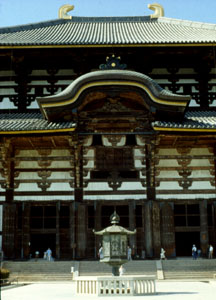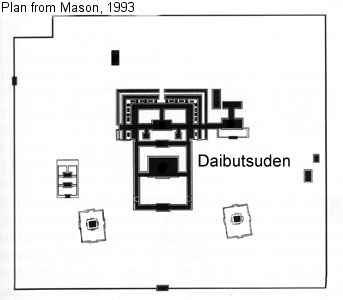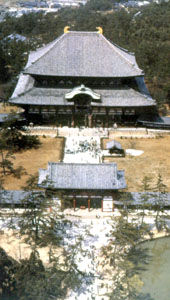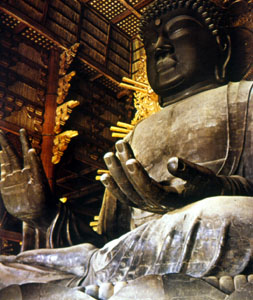Todai-ji |
|
The Daibutsuden, or Hall of the Great Buddha, of the Todai-ji temple claims the distinction of being the largest wooden structure in the world. Although rebuilt to only two thirds its original size in 1567 after the original was destroyed by a fire, the Daibutsuden spans a length of 188 feet, a width of 166 feet and a height of 157 feet. It exemplifies the idea of large monumental temples from the Nara period with its great size and expense built within the confines of the city. The Todai-ji complex or Great Eastern Monastery of Nara, was originally established in 751 AD in a 64 block sector in the eastern portion of Nara. It was ordered that all provinces would construct their own main temples to unite the nation and thus the intention of the Todai-ji was for it to become the central Buddhist temple of all of Japan. As a result, the main temple was constructed to be the most elaborate and monumental of all the temples. Nothing was too expensive. The complex included not only the Daibutsuden,
but also two seven story
pagodas, a lecture hall and monk’s quarters.
A colonnaded corridor surrounds the Daibutsuden in a similar plan
as the main complex at Horyu-ji. The whole complex is
symmetrically aligned through a north-south axis cutting through the
center of the Nandaimon, the Great South Gate, the Chumon,
Middle gate, the Daibutsuden, and the lecture hall. The original Daibutsuden was completed in 751 AD. It was 170 feet wide, 290 feet long and 163 feet high. The plan called for the width to have seven bays in a north-south orientation, and eleven bays in an east-west orientation. The building houses a monumental 53 foot high statue of the Buddha. The bronze statue was cast in 40 sections and then gilded with gold. As large as the structure was, it is believed that the Daibutsuden was still too small to adequately contain the statue and today, the building barely allows for people to see the statue in its entirety. The Nara period marked a historical era of Japan in which Buddhism explodes onto the scene in a big way. The Todai-ji is a great illustration of the expense to which temples were being produced in order to embellish this new religion and to make it a key part of Japan. It became the quintessential temple of the Nara period because of the amount of money and labor that was spent. Centuries will pass before we see such a grand and monumental structure constructed in Japan.
Back to Nara Period
|



